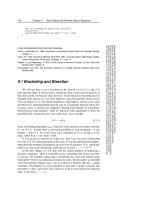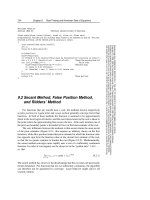Tài liệu The Legal and Economic Implications of Electronic Discovery pptx
Bạn đang xem bản rút gọn của tài liệu. Xem và tải ngay bản đầy đủ của tài liệu tại đây (285.7 KB, 40 trang )
This document and trademark(s) contained herein are protected by law as indicated in a notice appearing later in
this work. This electronic representation of RAND intellectual property is provided for non-commercial use only.
Unauthorized posting of RAND PDFs to a non-RAND Web site is prohibited. RAND PDFs are protected under
copyright law. Permission is required from RAND to reproduce, or reuse in another form, any of our research
documents for commercial use. For information on reprint and linking permissions, please see RAND Permissions.
Limited Electronic Distribution Rights
This PDF document was made available from www.rand.org as a public
service of the RAND Corporation.
6
Jump down to document
THE ARTS
CHILD POLICY
CIVIL JUSTICE
EDUCATION
ENERGY AND ENVIRONMENT
HEALTH AND HEALTH CARE
INTERNATIONAL AFFAIRS
NATIONAL SECURITY
POPULATION AND AGING
PUBLIC SAFETY
SCIENCE AND TECHNOLOGY
SUBSTANCE ABUSE
TERRORISM AND
HOMELAND SECURITY
TRANSPORTATION AND
INFRASTRUCTURE
WORKFORCE AND WORKPLACE
The RAND Corporation is a nonprofit research
organization providing objective analysis and effective
solutions that address the challenges facing the public
and private sectors around the world.
Visit RAND at www.rand.org
Explore the RAND Institute for Civil Justice
View document details
For More Information
Purchase this document
Browse Books & Publications
Make a charitable contribution
Support RAND
This product is part of the RAND Corporation occasional paper series. RAND
occasional papers may include an informed perspective on a timely policy issue, a
discussion of new research methodologies, essays, a paper presented at a conference, a
conference summary, or a summary of work in progress. All RAND occasional papers
undergo rigorous peer review to ensure that they meet high standards for research
quality and objectivity.
INSTITUTE FOR CIVIL JUSTICE
The Legal and
Economic Implications of
Electronic Discovery
Options for Future Research
James N. Dertouzos, Nicholas M. Pace,
Robert H. Anderson
The RAND Corporation is a nonprofit research organization providing objective analysis
and effective solutions that address the challenges facing the public and private sectors
around the world. RAND’s publications do not necessarily reflect the opinions of its
research clients and sponsors.
R
®
is a registered trademark.
© Copyright 2008 RAND Corporation
All rights reserved. No part of this book may be reproduced in any form by any electronic or
mechanical means (including photocopying, recording, or information storage and retrieval)
without permission in writing from RAND.
Published 2008 by the RAND Corporation
1776 Main Street, P.O. Box 2138, Santa Monica, CA 90407-2138
1200 South Hayes Street, Arlington, VA 22202-5050
4570 Fifth Avenue, Suite 600, Pittsburgh, PA 15213-2665
RAND URL:
To order RAND documents or to obtain additional information, contact
Distribution Services: Telephone: (310) 451-7002;
Fax: (310) 451-6915; Email:
Library of Congress Cataloging-in-Publication Data is available for this publication.
ISBN #978-0-8330-4422-8
The research described in this report was conducted within the RAND Institue for Civil
Justice (ICJ). ICJ research is supported by pooled grants from corporations, trade and
professional associations, and individuals; by government grants and contracts; and by
private foundations.
iii
Preface
is paper reports on exploratory research to identify the most important legal and economic
implications of electronic discovery and to develop a research plan in this subject area for the
RAND Institute for Civil Justice. To achieve these objectives, we reviewed the current state
of electronic discovery (e-discovery) law and practices, including the main features of the new
federal rules, interviewed several experts in electronic discovery issues as well as in-house coun-
sel for a number of very large corporations, conducted an initial modeling effort to simulate
the range of plausible effects of e-discovery on case outcomes, and analyzed the implications
of our results for future research.
is paper should be of interest to the research community and to those who are potential
funders of policy analysis in this area.
The RAND Institute for Civil Justice
e mission of RAND Institute for Civil Justice (ICJ) is to improve private and public deci-
sionmaking on civil legal issues by supplying policymakers and the public with the results of
objective, empirically based, analytic research. ICJ facilitates change in the civil justice system
by analyzing trends and outcomes, identifying and evaluating policy options, and bringing
together representatives of different interests to debate alternative solutions to policy prob-
lems. ICJ builds on a long tradition of RAND research characterized by an interdisciplinary,
empirical approach to public policy issues and rigorous standards of quality, objectivity, and
independence.
ICJ research is supported by pooled grants from corporations, trade and professional
associations, and individuals; by government grants and contracts; and by private foundations.
ICJ disseminates its work widely to the legal, business, and research communities and to the
general public. In accordance with RAND policy, all ICJ research products are subject to peer
review before publication. ICJ publications do not necessarily reflect the opinions or policies of
the research sponsors or of the ICJ Board of Overseers.
Information about ICJ is available online ( Inquiries about
research projects should be sent to the following address:
Robert T. Reville, Director
RAND Institute for Civil Justice
1776 Main Street
P.O. Box 2138
Santa Monica, CA 90407–2138
310-393–0411 x6786
Fax: 310-451–6979
v
Contents
Preface iii
Figure and Tables
vii
Summary
ix
Acknowledgments
xiii
Abbreviations
xv
SECTION 1
Introduction 1
Study Purpose and Approach
2
Key Concerns
2
Organization of is Paper
4
SECTION 2
e Current State of E-Discovery Law 7
Scarce Legal Guidance
7
Federal Rules of Civil Procedure Revisions
9
e Future of E-Discovery
12
SECTION 3
Exploratory Model of Case Outcomes 13
Litigation Costs and Benefits
13
Incentives to Settle
14
E-Discovery and the Costs and Benefits of Litigation
15
Probable Effects of E-Discovery
17
SECTION 4
Proposed Research Agenda 19
Conceptual Overview
19
Project Descriptions
20
Impact of E-Discovery on Litigation Outcomes
20
e Costs of E-Discovery
21
Forward-Looking Review of Emerging Technologies
21
Evaluation of Federal Rules
21
Assessment of Indirect Effects of E-Discovery on Business Practices
21
vii
Figure and Tables
Figure
4.1. Influence of Technology, Business Practices, and Legal Policy on Outcomes 20
Tables
2.1. Electronic Discovery Amendments to FRCP, December 2006 10
3.1. Probable Effects of E-Discovery by Case Type
18
ix
Summary
Pretrial discovery, involving the exchange of relevant information between litigants, is central
to the American civil legal process. With the development of computer technologies, most
information that is produced, distributed, and stored by business now exists in electronic form.
Based on a review of the literature, interviews with practitioners (corporate counsel, informa-
tion technology [IT] directors, and independent law firms) and a preliminary modeling effort,
this paper identifies several salient legal and economic issues raised by e-discovery and proposes
an agenda of research designed to improve future policy.
New technology can promote the efficient flow of information, thereby improving the
civil justice system. However, if not managed properly, it is also possible that the sheer volume
and complexity of electronically stored information (ESI) can increase litigation costs, impose
new risks on lawyers and their clients, and alter expectations about likely court outcomes. Such
changes could influence litigation patterns such as the propensity to file suits, the amounts of
settlements, and the frequency of trials. In addition, businesses could face higher operational
costs as they adopt technologies and IT practices in response to the likelihood of e-discovery
requests. ese costs could well increase dramatically with the size, scope, and complexity of
business functions. On the other hand, smaller businesses, with less sophisticated technolo-
gies and methods for responding to e-discovery requirements, may face a disadvantage in the
competitive world of litigation.
In response to concerns raised about these issues, there have been recent changes in the
Federal Rules of Civil Procedure that focus on electronic discovery. However, many questions
remain about their implementation, likely impact, and whether similar rules should be adopted
at the state level. Furthermore, anticipated changes in technology, such as new communica-
tions platforms, improved search tools, and increased storage capacity, are likely to alter the
future landscape significantly. us, e-discovery will be a topic of considerable policy impor-
tance for many years.
Given the importance of these issues, the RAND Institute for Civil Justice is supporting
new research on e-discovery. is paper presents the results of an exploratory study to identify
the most important legal and economic implications of e-discovery and to develop a plan of
research to be conducted over the next several years. Our approach involved four tasks: We
conducted multiple interviews with plaintiff and defense attorneys as well as IT personnel and
in-house counsel for a number of large corporations; we reviewed the current state of e-discov-
ery law and practices, including the main features of the new Federal Rules of Civil Procedure;
we conducted an initial modeling effort to simulate the range of plausible effects of e-discovery
on case outcomes; and we analyzed the implications of our results for future research.
x The Legal and Economic Implications of Electronic Discovery: Options for Future Research
Results of Interviews
Our interviews highlighted a number of concerns about the effects of e-discovery on the legal
system. First, the most frequent point mentioned in interviews was the rising costs of reviewing
information produced in e-discovery. Interviewees claimed that as much as 75 to 90 percent of
cost increases come from the additional time it takes attorneys to conduct an “eyes-on” review
of electronic documents. Although interviewees acknowledged that certain types of litigation
may be less affected by these trends, it is likely that, in many areas of litigation, increasing costs
are changing perceptions about case value and influencing incentives to file suits, settle cases,
and go to trial.
Second, interviewees expressed concern about the vulnerability of electronic evidence:
ose requesting evidence emphasized the risk of willful tampering or destruction of evidence,
and those producing evidence emphasized the potential for significant sanctions for inadver-
tent failure to preserve information.
ird, interview results were mixed concerning the new federal rules on e-discovery.
Although many interviewees were optimistic that the new rules would reduce inconsisten-
cies among states in handling electronic evidence, they felt that the regulations did not go far
enough to clarify the steps that should be taken with potential evidence in advance of and
during litigation.
Current State of E-Discovery Law
Despite all the concern about e-discovery, there have been very few judicial rulings at either the
federal or state level to help litigants make decisions about such evidence. Because only a hand-
ful of states have had formal rules of discovery tailored to electronic data and because appellate
cases are silent on the subject, typically existing laws that govern paper-based discovery have
been applied to electronic data. e few trial court decisions that have explored e-discovery
issues have provided some guidance to the legal community. Besides those, until the Federal
Rules of Civil Procedure were enacted in December 2006, two other sources have been used to
define certain parameters: the Sedona Conference guidelines and the American Bar Associa-
tion’s Civil Discovery Standards.
e new federal rules are expected to influence the way electronic evidence is understood
and handled in many states. ey define with more specificity what e-discovery includes and
they clarify how it should be produced. For example, the rules distinguish between relevant
data that are “reasonably accessible” and must be produced without complaint and data that
would impose an undue burden or expense to retrieve and therefore must be identified and
preserved but need not be produced unless requested by the judge. e new rules also offer
guidance about the format for production, what to do when privileged information is inadver-
tently shared, and what restrictions apply to sanctions for data lost in circumstances that were
clearly unintended.
However, the new rules leave a number of key questions unresolved: For example, what
constitutes “reasonably accessible” data? What steps should be taken to preserve electronic
information that might be sought as evidence? And what are the potential legal ramifications
of adopting different business practices?
Summary xi
Results of Exploratory Modeling
To explore the potential impact of e-discovery on litigation outcomes, we developed an illus-
trative model of legal decisionmaking. Although the work is preliminary, it indicates that a
theoretical model can lead to testable empirical results developed in future studies. e simula-
tions produced by the preliminary model identify a range of plausible effects of e-discovery on
litigation, depending on certain case characteristics.
e model assumes that plaintiffs and defendants form expectations of litigation costs
and benefits based on the information they receive about likely legal outcomes. e expected
value of a case to plaintiffs, for example, is their estimate of the probability of a range of pos-
sible awards, including the chance that they will lose the case. For defendants, the value of a
case represents a risk-adjusted expected liability based on a perceived range of plausible case
outcomes and their probabilities. Given their expectations, the parties in a case have incentives
either to settle or to move to the next phase of the legal process.
e influence of e-discovery on outcomes depends on whether the e-discovery process
adds information that changes perceptions about either case value or costs. For example, e-dis-
covery can provide information that changes perceptions of expected case values. Before dis-
covery, an assessment of case value depends on a range of expected case outcomes based on
closely held information. But after e-discovery, these expectations are modified. If the plaintiff
discovers information that strengthens his or her case, for example, then settlement demands
will increase.
E-discovery could also increase or decrease production costs. Clearly, the higher volume
of information requires a higher level of attorney review. E-discovery also increases certain
risks, such as the potential for severe sanctions or loss of attorney-client privilege. On the other
hand, improved technologies for storage, reproduction, and transmission of data could signifi-
cantly decrease some costs. It could also make it easier to identify relevant information and
thereby reduce the need for “eyes-on” attorney review.
In general, this theoretical model of litigant behavior suggests a number of effects of
e-discovery on case outcomes, depending on case characteristics. For example:
An increase in costs for both parties will increase the probability of settlement. A decrease
in costs will have the opposite effect.
An increase in defense costs will increase settlement amounts, while an increase in plain-
tiff costs will have the opposite effect. Again, these effects are reversed if costs decline.
Increased information exchange will tend to diminish the gap in expectations about trial
outcomes and increase the number of early settlements.
E-discovery, to the extent that it increases perceived risks for either party early in the pro-
cess, will encourage early settlement.
is model suggests that e-discovery will have different levels of effects on different types
of cases, such as employment cases, business-versus-business cases, regulatory cases, and class-
action cases. We offer illustrative examples of these effects in this paper, which we propose to
examine more closely through econometric analysis of actual case outcomes obtained from a
survey of law firms, as described below.
xii The Legal and Economic Implications of Electronic Discovery: Options for Future Research
Proposed Research Agenda
Because e-discovery will affect litigation outcomes within a complex and interactive system
that includes technology, business practices, and public policy, the independent effects of one
component must be evaluated in terms of the others. Federal and state rules and case law, for
example, will be influenced by the evolution of technology and prevailing business practices.
Such policies will have a direct effect on legal outcomes as well as business practices. We pro-
pose five studies that focus on particular elements of this system, but our ultimate goal is to
integrate what we learn so that we can maintain a full system perspective on the issue.
Impact of E-Discovery on Litigation Outcomes
Based on a new model of litigant decisionmaking and econometric analysis of survey data on
actual case outcomes, this project will evaluate the impact of new technology and e-discovery
rulemaking and judicial decisions on litigation patterns such as propensities to file cases, litiga-
tion costs, propensity to settle, settlement amounts, and probability of going to trial. In con-
ducting this research, we will consider impacts on both plaintiffs and defendants.
The Costs of E-Discovery
is research will develop a cost model, based on technical information and analysis of survey
data, that links discovery costs with several observable characteristics, including company size,
industry, IT structure, data location, case type, and regulatory retention requirements. One
product from this task will be a cost guidebook that would enable courts to evaluate the likely
burden of discovery requests.
1
Forward-Looking Review of Emerging Technologies
With anticipated changes in information technologies, present rules may not be effective or
even meaningful in the future. is project will involve a forward-looking review of emerging
technologies likely to affect the e-discovery cost-benefit calculus, and it will evaluate the impli-
cations for the relative efficacy of alternative legal requirements.
Evaluation of Federal Rules
Although evaluating the impact of the federal rules will be difficult until well after their imple-
mentation (December 2006), the project will conduct an initial evaluation based on theory,
available cost data, and an evaluation of early indicators such as numbers of sanctions and the
form of e-discovery requests and required productions.
Assessment of Effects of E-Discovery on Business Practices
In assessing the potential burdens of e-discovery, one has to consider the effects on business
operations. To quantify these potential impacts, we intend to gather and analyze information
on prevailing IT practices and technologies as well as the extent to which they may have been
altered in response to e-discovery concerns.
1
Of course, it may be that costs vary significantly on the basis of factors that cannot easily be identified and accounted
for ex ante. In such a case, the guidebook’s value will be based on establishing a feasible range of estimates that will require
additional analysis on a case-by-case basis.
xiii
Acknowledgments
We would like to thank our formal reviewers, Jeff Dominitz and Bruce Margolin, for extremely
thoughtful reviews. In addition, several other individuals provided constructive comments,
including Charles Beach, Sheila Birnbaum, Jay Greer, Rick Hauser, William Lynch, Robert
Peck, Kathleen Peterson, Paul Rheingold, Tom Rowe, Larry Stewart, Lynne Yowell, Craig
Zahnd, and Christian Zeunert. It goes without saying that the authors retain full responsibil-
ity for any remaining errors.
xv
Abbreviations
ABA American Bar Association
e-discovery electronic discovery
ESI electronically stored information
FRCP Federal Rules of Civil Procedure
IT information technology
PDA personal digital assistant
VoIP voice over Internet Protocol
1
SECTION 1
Introduction
Discovery is at the very heart of the civil process in America. Access to relevant evidence is
central to the “search for truth.” e discovery process is performed ostensibly in preparation
for trial, but in fact the information obtained is a key factor in driving negotiated resolutions
of disputes. In addition, discovery can be a major cost driver.
1
Given the importance of dis-
covery, it is not surprising that litigants and the lawyers who represent them are struggling in
their efforts to cope with the changes in the legal landscape due to the evolution of information
technologies.
2
Today, virtually all information is in electronic form. Electronically stored information
grew at the rate of 30 percent annually from 1999 through 2002. By 2002, less than one-tenth
of 1 percent of information was on paper copies.
3
e sheer volume is astounding. A data pro-
cessing center for a major corporation can contain 10,000 tapes or more. One tape can store as
much as a 1 trillion bytes (1 terabyte) of information or even more. If converted to hard copies,
information contained on a single tape would be the equivalent of a 200-mile-high stack of
paper.
e types of “discoverable” data in electronic form are also proliferating. Many are simi-
lar to previous hard-copy documents such as might be found in the printed output of Micro-
soft Word files and Excel spreadsheets. But discovery also includes more transitory forms that
were never found in the pre-electronic world, with the primary example being email messages.
A 2002 estimate put the number of emails sent worldwide at over 30 billion and predicted
that that number would double by 2006.
4
In addition, companies retain vast relational data-
bases that are continuously updated. ese systems contain payroll, sales, manufacturing, and
supplier transactions and provide a snapshot of an entire enterprise, something not possible
with hard-copy ledgers. A vast amount of information is stored on data recovery systems or
“backup” tapes. Historical information is retained on decades-old legacy systems that are now
difficult to access and read. Data that have supposedly been deleted from computers may still
in fact exist in “slack memory” and the various nooks and crannies of hard drives. Most appli-
1
In a study of federal cases from the 1992–1993 period, discovery-related activities represented an average of 36 percent of
all attorney time expenditures. See James S. Kakalik et al., Discovery Management: Further Analysis of the Civil Justice Reform
Act, RAND Institute for Civil Justice, MR-941-ICJ, 1998.
2
Fulbright and Jaworski, ird Annual Litigation Trends Survey, 2006. Only 20 percent of the survey’s 300 corporate
respondents indicated that they were “well-prepared” for the new requirements of e-discovery.
3
School of Information, University of California at Berkeley, How Much Information? 2003.
4
M. Levitt and R. P. Mahowald, Worldwide Email Usage Forecast, 2002–2006: Know What’s Coming Your Way, Interna-
tional Data Corporation, September 2002.
2 The Legal and Economic Implications of Electronic Discovery: Options for Future Research
cation and system files maintain a myriad of bookmark files, activity logs, and temporary files,
potentially leaving a detailed audit trail of internal corporate processes that was never imag-
inable before. Additionally, many application files (such as a Microsoft Word document) also
have embedded “metadata” that provide details about the author or the history of edits or other
activities. And to complicate matters even more, the stand-alone desktop computer is now only
one source of data, given the explosion of various platforms capable of holding electronically
stored information. ese include personal digital assistants (PDAs), laptops, thumb drives,
telephone calls that are placed through the internet (via voice over Internet Protocol, [VoIP]),
smart cards, and cell phones.
What are the implications of this proliferation of electronic data on the legal discovery
process? What are the costs and benefits of these trends? What are their likely impacts on
litigation outcomes? How are business practices changing in response to these developments?
Do the Federal Rules of Civil Procedure (FRCP) that were enacted in December 2006 help
litigants address the issues raised by e-discovery? How can policies be improved regarding
e-discovery? ese are some of the questions yet to be addressed by the research community.
Study Purpose and Approach
is paper presents the results of an exploratory effort to identify the most salient legal and
economic implications raised by e-discovery and to propose a research agenda for the RAND
Institute for Civil Justice (ICJ) to help inform policy in this area. e study included several
tasks. First, we conducted interviews with informed parties to learn their perceptions of the
effects of e-discovery on the legal system. Second, we reviewed the current state of e-discovery
law and practices, including the main features of the new Federal Rules of Civil Procedure.
ird, we conducted a preliminary modeling effort to simulate the range of plausible effects of
e-discovery on case outcomes. Finally, based on the results of these tasks, we proposed several
inter-related research projects to be conducted by the ICJ over the next several years.
In this chapter, we describe what we learned from our interviews and then set out the
organization of this paper.
Key Concerns
We interviewed officials from the information technology (IT) and litigation departments of
eight corporations, including representatives of the energy, insurance, pharmaceutical, and
telecommunications sectors. In addition, we had discussions with several defense and plaintiffs’
attorneys who have recently represented clients in a wide range of litigation, including anti-
trust, contract, employment, and product liability cases. Of course, this is not a representative
sample of all litigation or all litigants and, although many interviewees identified e-discovery
as an important issue, it was clear from our discussions that there may be a large subset of cases
mostly unaffected by the shift from paper to electronic data.
Despite the potential of computer technology to make storage, search, and exchange of
information less expensive and less time-consuming, the most frequent issue raised by those
we interviewed was the enormous costs—in time and money—to review information that is
produced. is is because the sheer volume of records that are identifiable and producible is
Introduction 3
greater with electronic processes, potentially relevant information that might never have been
recorded previously is now being routinely retained, and because the requesting attorneys are
aggressive in seeking out such information. Despite the technical advantages of modern IT sys-
tems, electronic documents still have to be individually examined by producing attorneys for
relevance and privilege concerns before they are delivered to the requesting side. Interviewees
indicated that as much as 75 to 90 percent of additional costs attributable to e-discovery are
due to increases in attorney billings for this “eyes-on” review of electronic documents.
Many of these concerns focused on email, although it is our perception that issues related
to transactional databases (orders, production, sales, pricing) are also potentially significant
because these files are complex, idiosyncratic, and designed primarily to specific business, as
opposed to legal, purposes. In addition, these files are not always in a form that is easy to inter-
pret. In such cases, the burden of transforming the format of information can be significant.
Corporate litigants also voiced concern over their inability to provide convincing docu-
mentation about the magnitude of costs associated with broad e-discovery requests. Some of
these litigants asserted that many judges do not have an adequate grasp of the technical and
cost issues raised by e-discovery and continue to apply paper-based thinking when ruling on
discovery disputes. In their view, the potential relevance of requested information was gener-
ally outweighed by the imposed burdens. ese burdens are likely to increase exponentially
with the size, complexity, and scope of the business enterprise. On the other hand, many firms
cited a more routinized and efficient e-discovery production process as a competitive advantage
in business-versus-business litigation.
As a result of these increased costs of discovery, the legal process may have become more
expensive.
5
In small-value cases, these costs could dominate the underlying stakes in dispute.
Depending on the legal and factual questions and the discovery issues at play, plaintiffs may
have a higher probability of suing and defendants may be more likely to settle in some types
of litigation. In addition, e-discovery also affects the flow of information and changes expecta-
tions about likely case outcomes. In all kinds of cases, changes in the magnitude and structure
of litigation costs, as well as changed perceptions about case value, will alter litigant incentives
to file suits, settle cases, and go to trial.
Interviewees suggested that the relevance of these issues could vary by case type. For
example, e-discovery could have quite different but predictable impacts on employment, prod-
uct liability, regulatory, and class-action litigation. It is also worth noting that, although our
focus has been on civil litigation, the duty to preserve relevant data is even greater in criminal
cases.
It is also the case that corporations are changing standard business practices because they
are required to comply with e-discovery requests as well as other regulatory obligations. For
example, new corporate oversight regulations (e.g., the Sarbanes-Oxley Act of 2002
6
) in effect
require retention of large data sets for multiple years. Such data are also discoverable in litiga-
tion, thereby increasing potential e-discovery burdens. In addition, companies may be reluc-
tant to adopt new technology or software that increases e-discovery risks. For example, some
companies have banned instant messaging or the installation of edit-tracking applications for
Microsoft Word documents because of the potential litigation impacts. Record-retention rules
5
e extent to which costs have increased remains an empirical question that requires additional research. In the absence
of reliable cost data, such burdens cannot be weighed against the potential benefits of improved information.
6
Public Law No. 107-204, e Sarbanes-Oxley Act of 2002, July 30, 2002.
4 The Legal and Economic Implications of Electronic Discovery: Options for Future Research
and data-backup policies have been modified at some companies as a result of similar concerns.
ose who regularly make e-discovery demands on businesses asserted that some of these
changes in technology and records management practices were instituted primarily to prevent
the release of relevant information rather than to control costs.
Interviewees also noted that, although more information can be produced, relevant evi-
dence is quite vulnerable. Files can be tampered with, overwritten, destroyed, or hidden with
the stroke of a key. Of course, new technologies make it virtually impossible to truly elimi-
nate all aspects of computerized records. Attempts to remove data are often not successful
despite apparent confirmation that files were successfully deleted. It is interesting that, whereas
requesting parties worried about the potential for willful destruction, those responding to dis-
covery requests were concerned about the potential for significant sanctions for inadvertent
failure to preserve information.
Business litigants display a mix of optimism and concern about the impact of the new
federal rules on e-discovery that went into effect in December 2006. To some extent, the bal-
kanization that marked federal decisions in this area is likely to be reduced, but the core con-
cerns over uncertainty about what are reasonable steps to take in advance of and during litiga-
tion remain. us, it is apparent that further clarification and development of e-discovery rules
that promote efficiency and equity for both defendants and plaintiffs are required.
For example, the new federal rules require early and full disclosure of IT systems, but
interviewees noted that many lawyers are unfamiliar with the modern and continuously evolv-
ing hardware, applications, and internal record-keeping practices of their clients. Lawyers risk
significant sanctions for failing to properly carry out e-discovery duties that they may not
be equipped to handle. Even technologically savvy attorneys voiced concerns that providing
opposing parties with detailed IT “roadmaps” as envisioned under the new rules would lead
to discovery demands designed solely to drive up costs. And as corporate clients increasingly
move toward internalizing collection, review, and production tasks in order to limit litigation
costs, their outside counsel may find themselves with reduced control over the process but nev-
ertheless still vulnerable to sanctions.
In discussing the future legal landscape, interviewees raised several potential uncertain-
ties. For example, with the proliferation of new IT-generated information, does the definition
of “relevancy” expand? What is discoverable and when? What are the best practices for pres-
ervation of relevant data? Should standard business IT and record-management practices be
altered? Under what circumstances does the burden of production outweigh the benefits? In
such cases, should cost shifting be required (in most discovery practice, the costs of production
fall on the producing party)? And what happens when privileged information is inadvertently
disclosed because of the vast volume of information being provided? Is attorney-client privilege
automatically waived? Are current standards for sanctions appropriate for the highly complex
nature of electronic data?
Organization of This Paper
In the next section, we provide a brief overview of the current state of e-discovery law and prac-
tices. We describe the most important features of the recently adopted federal rules and assess
their likely impact. Next, we present the results of an initial modeling effort to simulate the
range of plausible effects on case outcomes. We demonstrate that case patterns, such as filing
Introduction 5
rates, settlement incentives, payments, and jury awards, can depend on variables likely to be
affected by e-discovery. Preliminary results also suggest that the impact on such outcomes is
likely to vary significantly by case type. e concluding section ends with an agenda for future
research. We describe five potential projects on e-discovery.









